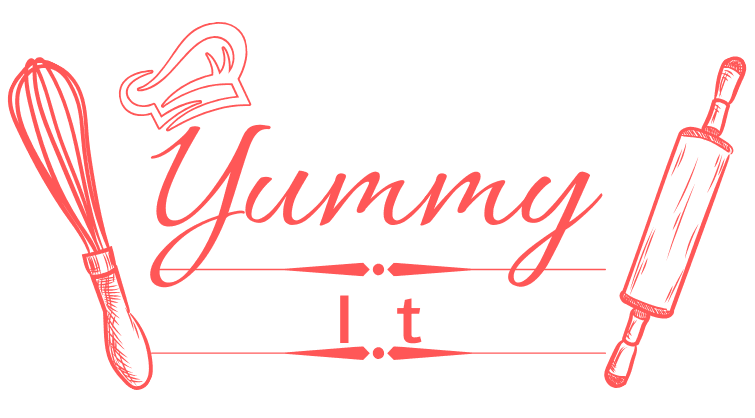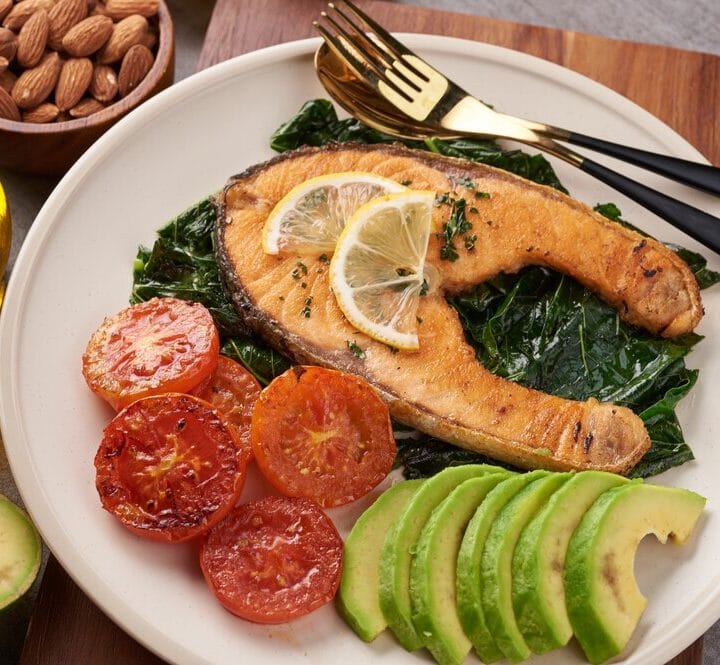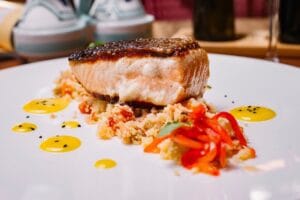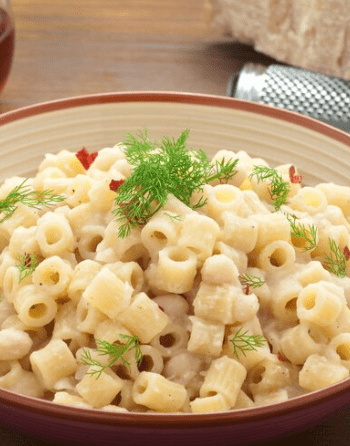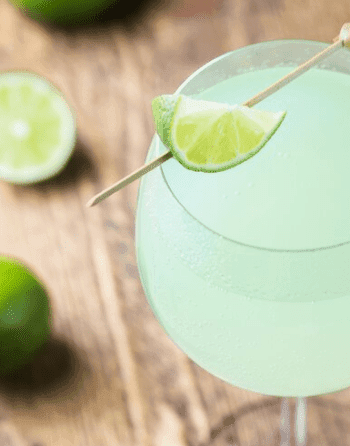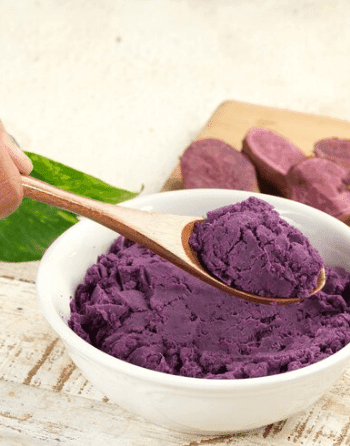Crafting your own fish food recipe is a rewarding way to ensure your aquarium inhabitants receive high-quality nutrition tailored to their specific needs. Whether you care for herbivores, carnivores, or omnivores, creating homemade fish food allows you to control ingredients, eliminate harmful additives, and save money. This comprehensive guide provides everything you need to know, from understanding fish dietary requirements to step-by-step recipes, storage tips, and troubleshooting common issues.
If you’re a fan of fish recipes, don’t miss our delicious trout recipe for a perfectly cooked, flavorful meal
Why Choose Homemade Fish Food Recipe?
Making your own fish food comes with numerous advantages, benefiting both your fish and your wallet:
- Customized Nutrition: Tailor recipes to the unique dietary requirements of your fish species.
- Cost-Effective: Ingredients like vegetables and protein sources can be bought in bulk, saving money over time.
- Freshness and Quality: Homemade food eliminates unnecessary preservatives, ensuring your fish consume fresh, natural meals.
- Adaptable for All Species: Recipes can be modified to suit herbivorous, carnivorous, or omnivorous fish.
For those just starting out, learning the basics of fish nutrition is essential. Check out this guide on fish nutrition for a deeper understanding of what your fish need to thrive.
Understanding Fish Food Recipe Nutrition
Creating a balanced fish food recipe requires knowledge of essential nutrients that keep fish healthy and vibrant. Here’s what your fish need:
1. Proteins
- Vital for growth, repair, and overall development.
- Essential for carnivorous and omnivorous species.
- Sources: Fish fillets, shrimp, mussels, and egg yolks.
2. Fats
- Provide energy and contribute to vibrant coloration.
- Support healthy cells and immune function.
- Sources: Fish oils and omega-3 supplements.
3. Carbohydrates
- Offer energy but should be limited, as fish metabolize carbs differently than mammals.
- Herbivorous fish benefit most from plant-based carbs.
- Sources: Spinach, peas, and zucchini.
4. Vitamins and Minerals
- Strengthen immunity, promote growth, and prevent deficiencies.
- Sources: Spirulina, seaweed, and crushed multivitamins.
Common Ingredients for Homemade Fish Food Recipe
Below are the main ingredients commonly used in DIY fish food recipes:
Protein Sources
- Fish fillets: Low-fat options like cod or tilapia.
- Shrimp: Fresh or frozen shrimp provide high-quality protein.
- Egg yolks: Rich in protein and suitable for fry or small fish.
Plant-Based Ingredients
- Spinach: High in iron, perfect for herbivorous fish.
- Peas: Helps with digestion, especially for goldfish.
- Zucchini: A soft, nutritious vegetable suitable for most species.
Binders
- Gelatin: Keeps food portions intact underwater.
- Agar-agar: A vegetarian alternative to gelatin.
Supplements: Fish Food Recipe
- Spirulina powder: Enhances color and provides antioxidants.
- Fish oil: Boosts omega-3 fatty acids.
- Crushed vitamins: Completes the nutrient profile of your recipe.
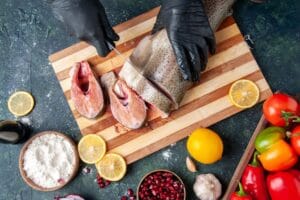
Step-by-Step: Gelatin-Based Fish Food Recipe
This versatile recipe works well for most fish species, ensuring they receive a balanced and healthy diet.
Ingredients
- ½ cup fish fillets or shrimp
- ¼ cup steamed vegetables (spinach, peas, zucchini)
- 1 tsp spirulina powder
- 1 packet unflavored gelatin
- Water as needed
Instructions: Fish Food Recipe
- Prepare Ingredients: Steam the vegetables until soft. Thaw frozen proteins like shrimp or fish if needed.
- Blend Ingredients: In a food processor, combine the fish, vegetables, and spirulina powder. Blend until smooth.
- Prepare Gelatin: Mix gelatin with warm water according to packet instructions.
- Combine and Portion: Add the gelatin mixture to the pureed ingredients. Stir until fully incorporated, then pour into ice cube trays or silicone molds.
- Refrigerate: Allow the mixture to set in the refrigerator for 3-4 hours.
- Store: Freeze individual portions for long-term storage and thaw before feeding.
Alternative Recipes for Specific Fish Types
Homemade fish food can be tailored to the specific needs of herbivorous, carnivorous, and fry fish species. These alternative recipes ensure all your fish receive the nutrients they require for optimal health and vitality.
1. Herbivorous Diet
Herbivorous fish thrive on plant-based foods rich in fiber, vitamins, and minerals.
Ingredients:
- Spinach: High in iron and essential nutrients.
- Peas: A natural laxative that aids digestion, especially for goldfish.
- Zucchini: Soft and easy to consume.
- Spirulina powder: A superfood that boosts immunity and enhances coloration.
- Agar-agar: A plant-based binder that keeps the food intact in water.
Instructions: Fish Food Recipe
- Steam Vegetables: Lightly steam the spinach, peas, and zucchini to soften them while retaining nutrients.
- Blend: Combine the steamed vegetables and spirulina powder in a blender. Blend into a smooth paste.
- Bind: Add agar-agar to the mixture and stir until fully incorporated.
- Portion: Pour the mixture into molds or trays and refrigerate until set.
This recipe ensures herbivorous fish receive the fiber and nutrients they need for vibrant health and digestion.
2. High-Protein Carnivore Food
Carnivorous fish require a diet rich in proteins to support growth, energy, and overall health.
Ingredients:
- Shrimp: Packed with protein and essential fatty acids.
- Mussels: Provide a natural source of minerals like zinc and copper.
- Fish fillets: Choose lean options like cod or tilapia.
- Fish oil: Adds omega-3 fatty acids for energy and cell health.
Instructions: Fish Food Recipe
- Prepare Ingredients: Thaw frozen proteins like shrimp and mussels, and cut the fish fillets into smaller pieces.
- Blend: Blend all ingredients into a thick, consistent mixture.
- Bind: Add unflavored gelatin to bind the food and ensure it holds together underwater.
- Portion and Freeze: Divide the mixture into small portions, freeze, and thaw before feeding.
This recipe is ideal for predatory fish like cichlids and bettas, providing the high protein content they need to thrive.
3. Fry Food
Fry, or baby fish, need a soft, nutrient-dense diet that supports their rapid growth and development.
Ingredients:
- Boiled egg yolks: A rich source of protein and fat, easy for fry to digest.
- Spirulina powder: Boosts immunity and coloration from an early age.
- Gelatin: Helps hold the food together in small, manageable portions.
Instructions: Fish Food Recipe
- Boil Egg Yolks: Cook the egg yolks thoroughly, then mash them into a smooth paste.
- Mix with Spirulina: Add spirulina powder for added nutrients.
- Bind and Portion: Use gelatin to bind the mixture, then create tiny servings suitable for fry.
- Store: Refrigerate or freeze portions for easy access during feeding.
This soft, nutrient-packed food ensures fry grow quickly and healthily, reducing the risk of developmental issues. Looking for more seafood inspiration? Check out our branzino recipe for a Mediterranean twist on this classic fish dish.
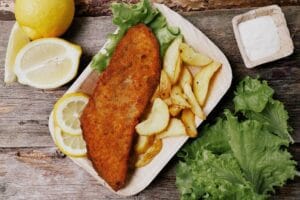
Best Practices for Feeding Homemade Fish Food Recipe
To maximize the benefits of your homemade fish food and maintain a clean, healthy aquarium, follow these best practices:
1. Portion Control
Overfeeding can lead to poor water quality and health issues. To prevent this:
- Feed only what your fish can consume within 2–3 minutes.
- Divide meals into smaller portions and offer multiple feedings throughout the day instead of one large serving.
By feeding the right amounts, you avoid waste buildup and ensure your fish receive just the nutrition they need.
2. Monitor Behavior
Fish may take time to adjust to homemade food, so it’s crucial to observe their behavior during feeding:
- If fish seem disinterested or refuse the food, adjust the recipe by tweaking ingredients or texture.
- Gradually introduce the homemade food alongside their regular diet to help them acclimate.
- Look for positive signs like active swimming and quick consumption as indicators of satisfaction.
Monitoring ensures your fish are getting the right nutrients while avoiding unnecessary waste.
3. Maintain Tank Cleanliness
Homemade fish food that isn’t consumed promptly can degrade and pollute the tank. To keep the environment clean:
- Remove uneaten food within 10 minutes to prevent it from decomposing.
- Perform regular water changes and monitor ammonia, nitrate, and pH levels to maintain a healthy balance.
- Use feeding tools like tweezers or feeders for precise food delivery, minimizing spillage.
Clean feeding habits keep your tank healthy and your fish stress-free, creating an ideal habitat for them to thrive.
Storage and Shelf Life
Frequently Asked Questions (FAQs)
What is the best homemade food for fish?
The best homemade fish food depends on your fish’s dietary requirements. For carnivorous fish, protein-rich foods like shrimp, fish fillets, and boiled egg yolks are excellent. For herbivorous fish, options such as steamed spinach, peas, and spirulina are ideal. A balanced recipe combining proteins, vegetables, and supplements like fish oil or crushed vitamins ensures your fish receive all necessary nutrients.
How do you make homemade fish feed?
Making homemade fish feed is simple and customizable. Follow these steps:
- Choose Ingredients: Include protein sources (shrimp, fish fillets), vegetables (spinach, peas), and binders (gelatin or agar-agar).
- Blend Ingredients: Puree all ingredients in a food processor.
- Bind the Mixture: Use gelatin to hold the food together.
- Set and Store: Portion the mixture into molds, refrigerate to set, and freeze for long-term storage.
By making DIY fish feed, you ensure your fish get a fresh and nutritious diet without additives.
What are the best ingredients for fish food?
The best fish food ingredients are:
- Proteins: Shrimp, fish fillets, mussels, and boiled egg yolks for growth and energy.
- Vegetables: Spinach, peas, zucchini, and spirulina powder for herbivores.
- Supplements: Fish oils, crushed multivitamins, and seaweed for added nutrients.
Choosing high-quality, natural ingredients ensures your fish stay healthy, vibrant, and active.
How to make live food for fish?
Creating live food for fish involves cultivating small, nutrient-rich organisms. Common options include:
- Brine Shrimp: Hatch brine shrimp eggs in saltwater and feed them to your fish.
- Daphnia (Water Fleas): Grow them in a controlled freshwater setup with algae.
- Microworms: Cultivate in a mixture of oats and yeast.
Live food is especially beneficial for fry and carnivorous fish, providing essential proteins and stimulation similar to their natural diet.
Conclusion
Making your own fish food recipe is not just an effective way to care for your aquatic pets—it’s also a rewarding experience that strengthens your connection with them. By tailoring the ingredients to meet their specific dietary needs, you ensure your fish receive the best possible nutrition to thrive. Proper nutrition contributes to vibrant colors, boundless energy, and overall health, helping your aquarium flourish with life and vitality.
Whether you’re preparing food for herbivorous goldfish, carnivorous cichlids, or omnivorous community fish, these homemade recipes provide endless opportunities for customization. The ability to control every ingredient means you can cater to the preferences and requirements of each species, avoiding unnecessary fillers or harmful additives found in many store-bought options.
Experimenting with homemade fish food not only benefits your fish but also empowers you as an aquarium owner. You’ll have the satisfaction of knowing that you’re providing your pets with a fresh, nutrient-rich diet crafted with care. As you explore different recipes, monitor your fish’s behavior, growth, and coloration to find what works best for them.
Start experimenting with these recipes today and take the first step toward a healthier, more sustainable feeding approach. For more insights into fish nutrition and feeding techniques, check out this guide on fish feeding guidelines. Your fish will thank you with their health, beauty, and lively presence. Happy feeding! 🐟🐠
